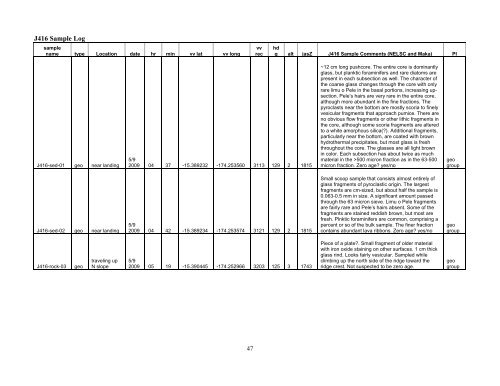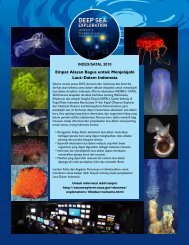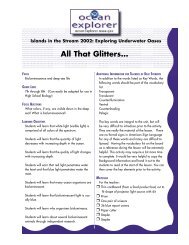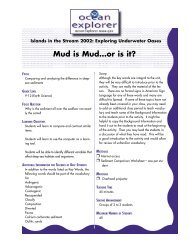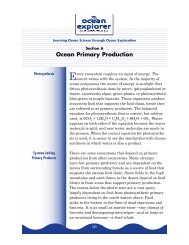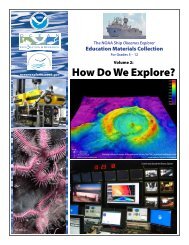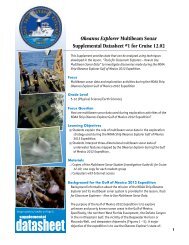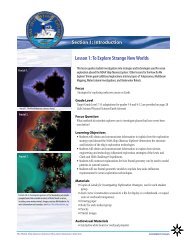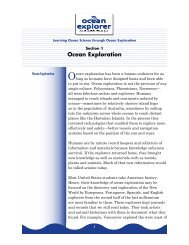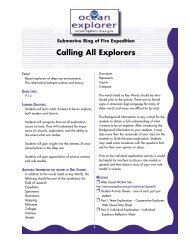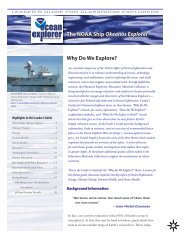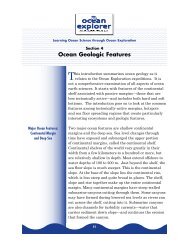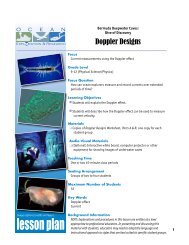Cruise Report (PDF, 4.8Mb) - NOAA, Ocean Explorer
Cruise Report (PDF, 4.8Mb) - NOAA, Ocean Explorer
Cruise Report (PDF, 4.8Mb) - NOAA, Ocean Explorer
You also want an ePaper? Increase the reach of your titles
YUMPU automatically turns print PDFs into web optimized ePapers that Google loves.
J416 Sample Log<br />
sample<br />
name type Location date hr min vv lat vv long<br />
J416-sed-01 geo near landing<br />
J416-sed-02 geo near landing<br />
J416-rock-03 geo<br />
traveling up<br />
N slope<br />
47<br />
vv<br />
rec<br />
5/9<br />
2009 04 37 -15.389232 -174.253560 3113 129 2 1815<br />
5/9<br />
2009 04 42 -15.389234 -174.253574 3121 129 2 1815<br />
5/9<br />
2009 05 19 -15.390445 -174.252966 3203 125 3 1743<br />
hd<br />
g alt jasZ J416 Sample Comments (NELSC and Maka) PI<br />
~12 cm long pushcore. The entire core is dominantly<br />
glass, but planktic foraminifers and rare diatoms are<br />
present in each subsection as well. The character of<br />
the coarse glass changes through the core with only<br />
rare limu o Pele in the basal portions, increasing upsection.<br />
Pele’s hairs are very rare in the entire core,<br />
although more abundant in the fine fractions. The<br />
pyroclasts near the bottom are mostly scoria to finely<br />
vesicular fragments that approach pumice. There are<br />
no obvious flow fragments or other lithic fragments in<br />
the core, although some scoria fragments are altered<br />
to a white amorphous silica(?). Additional fragments,<br />
particularly near the bottom, are coated with brown<br />
hydrothermal precipitates, but most glass is fresh<br />
throughout the core. The glasses are all light brown<br />
in color. Each subsection has about twice as much<br />
material in the >500 micron fraction as in the 63-500<br />
micron fraction. Zero age? yes/no<br />
Small scoop sample that consists almost entirely of<br />
glass fragments of pyroclastic origin. The largest<br />
fragments are cm-sized, but about half the sample is<br />
0.063-0.5 mm in size. A significant amount passed<br />
through the 63 micron sieve. Limu o Pele fragments<br />
are fairly rare and Pele’s hairs absent. Some of the<br />
fragments are stained reddish brown, but most are<br />
fresh. Plnktic foraminifers are common, comprising a<br />
percent or so of the bulk sample. The finer fraction<br />
contains abundant lava ribbons. Zero age? yes/no<br />
Piece of a plate?. Small fragment of older material<br />
with iron oxide staining on other surfaces. 1 cm thick<br />
glass rind. Looks fairly vesicular. Sampled while<br />
climbing up the north side of the ridge toward the<br />
ridge crest. Not suspected to be zero age.<br />
geo<br />
group<br />
geo<br />
group<br />
geo<br />
group


